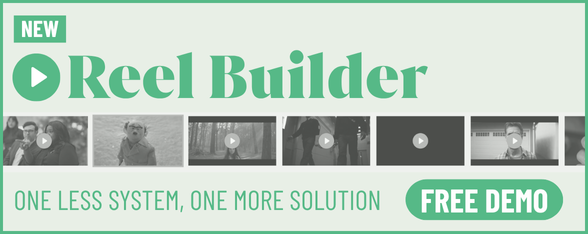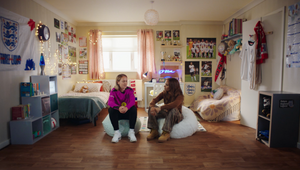
The Directors: Matias Nystedt

Matias Nystedt is an award winning director from Finland. As a film nut, he loves mixing different genres in his work and always adds visual flair to his films. He has a BA in film directing and screenwriting and a degree and background in graphic design, which comes across in his work. He’s a master of casting and, like most Finnish people, loves combining melancholy & humour in his work, and yet somehow, there's always heart in his characters.
As well as a host of commercials for global brands, in recent years he's also directed six TV shows in Finland, always bringing his unique style to create memorable characters and content.
Matias is fluent in Swedish, Finnish and English and is based in Helsinki (but very happy to travel!) Matias works with his producer Dan Heighes through Dark Energy Films.
LBB> What elements of a script sets one apart from the other and what sort of scripts get you excited to shoot them?
Matias> I've always loved commercials that feel like scenes taken from a movie, so I tend to gravitate towards story driven scripts. I love ideas that open up possibilities to tell the story by combining different aspects of film. Sometimes the camera placement tells the story, sometimes it's the character or the music or the lack thereof. The idea that this particular story could only be told in this way, using all the tools at my disposal, in this particular medium is interesting to me.
LBB> How do you approach creating a treatment for a spot?
Matias> I personally love writing treatments. But I've also become more picky as I've gained experience. If the initial idea doesn't spark my imagination early on, it's usually a sign that it's not my story to tell. But when the idea clicks, I usually start taking a whole lot of notes and gathering little nuggets of thoughts.
Early on, I usually try to find as much stimulus for my mind as possible. Watching films, other commercials, listening to music, anything really that can get my ideas going. I think the more diverse the pool of references is, the more chance there is of finding ideas that are out of the box. Once I've gathered enough ideas, it becomes about simplifying and stripping it down to the story that needs to be told.
LBB> If the script is for a brand that you're not familiar with/don’t have a big affinity with or a market you're new to, how important is it for you to do research and understand that strategic and contextual side of the ad? If it’s important to you, how do you do it?
Matias> I'm fine with letting the creative handle the brand strategy (as that would've been integral to the initial brief), so I tend to be more focused on finding my own way to approach the project. If the the brief is good, then the strategy is usually well baked in to the story. Having said that, I do my homework regarding the brand to familiarise myself and get my bearings on the project.
LBB> For you, what is the most important working relationship for a director to have with another person in making an ad? And why?
Matias> Of course it depends slightly on the project. During the shoot, the DP is usually the closest collaborator, and one that I cherish, but other than that I think the producer is the most important person for me.
When prepping the shoot for the Lynx 'Snowmobiles 2025' brand film, we had a complicated shoot, with different units working from different countries, so planning everything carefully with my producers Dan Heighes (UK) and Marjo Markkanen (FIN) was essential. So much of the production value and overall quality of a film is decided in pre-production, where you have to figure out as many details as possible.
The most successful projects I've worked on have been with good producers with whom collaboration is easy.
LBB> What type of work are you most passionate about - is there a particular genre or subject matter or style you are most drawn to?
Matias> I enjoy all genres really. I've found a good groove for working with comedic subjects, but I like to mix genres quite a lot. For instance, shooting a comedic spot like a drama film can be a lot more interesting and surprise the viewer. Whenever there's an opportunity to mix and combine styles, I get exited.
LBB> What’s the craziest problem you’ve come across in the course of a production – and how did you solve it?
Matias> For me, film making is all about problem solving. I love figuring out difficult shots and planning complicated scenes. When shooting my first short film 'Dead Serious', we had a really limited budget and had to work on a limited set.
For the climactic end scene we had a reverse shot of our two main characters speaking to each other, but we couldn't find a good spot to shoot in. So we ended up shooting it in a completely separate location with the same actors face-to-face and carefully planning the light, so that it would match both shots. It worked great and no one noticed that the two actors were in completely different locations while speaking to each other.
LBB> How do you strike the balance between being open/collaborative with the agency and brand client while also protecting the idea?
Matias> If the brief is good, and if the director's treatment is clear and detailed enough, then the idea should ideally align. Film making by its very nature is a collaborative process, so I don't find it to be any kind of compromise. As long as everyone can let go of ego as much as possible, then usually, the best ideas tend to stay afloat. For me, it' doesn't matter whose idea it is.
LBB> What are your thoughts on opening up the production world to a more diverse pool of talent? Are you open to mentoring and apprenticeships on set?
Matias> I don't have experience with apprenticeships on set, but I'm all for a diverse pool of talent. I've worked with people with all kinds of different backgrounds and I've always found it to be an enriching experience on set.
I do like the idea of apprenticeships. Early on I worked as an editor for a very experienced commercial director, named Olli Rönkä, in Finland. I learned so much from him, and the fact that he was willing to share his knowledge with me was a great lesson in and of itself. I believe in passing knowledge forward.
LBB> Your work is now presented in so many different formats - to what extent do you keep each in mind while you're working (and, equally, to what degree is it possible to do so)?
Matias> I cut my teeth as a filmmaker just as brands started creating content on YouTube and that was my way in to filmmaking. So for me, it's second nature to produce content on several platforms in different formats. I do notice that sometimes the secondary formats tend to feel like an afterthought, so I like to have an idea for the different formats in the initial treatment. That way, I force myself to give all formats a more equal footing with each other.
LBB> What’s your relationship with new technology and, if at all, how do you incorporate future-facing tech into your work (e.g. virtual production, interactive storytelling, AI/data-driven visuals etc)?
Matias> I'm a bit of a tech geek. I love figuring out different technological solutions for telling the story. As a filmmaker, it's about combining many tools from the toolbox as possible. I directed a TV promo for Discovery+ Finland where we made extensive use of virtual production. We created an entire jungle using Unreal engine and we combined digital effects with practical set design to create a seamless visual world.
LBB> Which pieces of your work do you feel show what you do best – and why? Include 3-4 links and a sentence or 2 about each piece of work!
Matias> LYNX - "Tougher than ever” campaign - I loved working on this project. The film is about “Sisu", a Finnish word that can't be directly translated into any other language. But it basically means a person with grit and perseverance in the face of unlikely odds.
We wanted to have our main character start the film in an ice hole in freezing cold water. We spent a lot of time casting the right person, and I'm really glad we found Timo-Pekka, who definitely has Sisu and ended up being the brand spokesperson for Lynx.
HELEN - This was another project were casting was essential. HELEN is a Finnish energy company who wanted to focus more on green energy and the idea was to have a slightly goofy female character who always has a sunny disposition.
PUHDAS ITÄMERI - I like "one-shot" films and I was really happy I got to direct this. The film was made on a fairly short schedule but we had a clear idea and a good crew and I'm really happy with the results.















